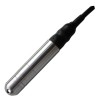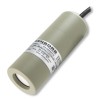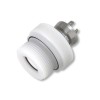Using a pressure measurement instrument to measure fuel level is very common, however most are scaled in bar or psi pressure ranges, and if they do happen to be scaled in level units, they are typically water level based, such as mH2O or ftH2O.
There are many different grades of liquid fuels which vary in density, plus changes in tank temperature will affect the density of one fuel type. So it is important to carefully consider the pressure range required to ensure that the level being measured never exceeds the operating range of the measurement device.
Featured tank level pressure measurement products
 DPT200 Pressurised Tank Level Differential Pressure Transmitter - Pressurised tank liquid level differential pressure cell transmitter for process plant storage.
DPT200 Pressurised Tank Level Differential Pressure Transmitter - Pressurised tank liquid level differential pressure cell transmitter for process plant storage. Wash water break tank submersible level transducer with 1.6 m range and 4-20mA output - Monitor wash water levels in break tanks with this submersible 4-20mA transducer. Features high accuracy, 5m vented cable, and robust design.
Wash water break tank submersible level transducer with 1.6 m range and 4-20mA output - Monitor wash water levels in break tanks with this submersible 4-20mA transducer. Features high accuracy, 5m vented cable, and robust design.
The conditions which will produce the maximum hydrostatic pressure, are the lowest tank temperature and the maximum tank level. If you know the density of the fuel at the lowest tank temperature and the maximum possible fuel height in the tank, then you can calculate the pressure range needed to ensure the instrument will never go over-range.
For an example, let’s say you have a Kerosene fuel tank that is 1,385 mm deep, with a maximum specific gravity of 0.82 corresponding to the lowest tank temperature of 15.6 degC. If you convert this to a hydrostatic pressure, it will come out as 0.1114 bar, 1135.7 mmH2O or 3.726 ftH2O pressure.
Featured tank level pressure measurement products
 Wash water break tank submersible level transducer with 1.6 m range and 4-20mA output - Monitor wash water levels in break tanks with this submersible 4-20mA transducer. Features high accuracy, 5m vented cable, and robust design.
Wash water break tank submersible level transducer with 1.6 m range and 4-20mA output - Monitor wash water levels in break tanks with this submersible 4-20mA transducer. Features high accuracy, 5m vented cable, and robust design. Chemical resistant level sensor for sodium hydroxide and bleach - Plastic-bodied submersible transmitter with a flush ceramic sensor provides reliable level measurement in a disinfection tank containing high-density, aggressive media.
Chemical resistant level sensor for sodium hydroxide and bleach - Plastic-bodied submersible transmitter with a flush ceramic sensor provides reliable level measurement in a disinfection tank containing high-density, aggressive media.
Related Help Guides
- Measuring the volume of liquid in a horizontal cylinder tank
- Measuring liquid level in a sealed tank with a hydrostatic pressure sensor
- Difference between vented and non-vented water level measurement
- Determining water tank volume using hydrostatic pressure
- How do you measure the volume of a liquid using pressure
- Measuring liquid level in a tank using a dp sensor
Related Technical Terms
- cmH2O – Centimetres of Water Column at 4 deg C Pressure Unit
- ftH2O – Feet of Water Column at 4 deg C Pressure Unit
- Hydrostatic Pressure
- mH2O – Metres of Water Gauge at 4 deg C Pressure Unit
- mmH2O – Millimetres of Water Column at 4 deg C Pressure Unit
- Specific Gravity
Related Online Tools
- Liquid Level to Hydrostatic Pressure Calculator
- Fluid Depth, Density, Gravity, and Pressure Calculator
- Pressure to Liquid Level Calculator


